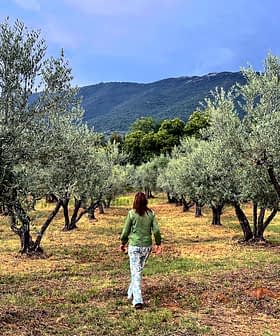Complex Harvest Challenges Italian Farmers
The Institute of Services for the Agricultural and Food Market released the first figures on the current harvest in Italy.
 Harvest in Gargano
Harvest in GarganoThe first figures available on the current crop season in Italy were compiled and released by the Institute of Services for the Agricultural and Food Market (ISMEA), on the basis of data gathered by the Italian Agricultural Payments Agency (AGEA). According to the early indications from the monitoring network, yet in absence of objective factors such as yield, the olive oil production volume for the 2018/19 harvest season has been estimated to reach 265,000 tons, which is equivalent to a 38 percent decline compared to the 429,000 tons for last year.
However, specialists at the Institute forecast that a further decrease up to 45 percent may occur by the end of the operations in the Italian olive groves since weather conditions could affect yield and quality of fruits. Actually, as the harvest proceeds and enters the final phase, a further decline in volumes appears increasingly likely, and some experts say this year’s production could hit a record low.
As mentioned in the Ismea’s report, taking into account the phenomenon of alternate bearing in olive trees, over the last six years the ‘off-years’ always occurred with a drop in production with an intensity that exceeded the physiological variation.
This was due to the action of several factors which contributed to significant downturns, as was the case of the 222,000 tons produced in 2014, a season characterized by the massive presence of the olive fruit fly, followed by the 182,000 tons of 2016, the worst harvest in recent decades. Experts point out that, in the history of Italian olive growing, negative seasons generally occurred every 15 years, while in recent times, due to the increasing frequency of anomalous climatic events, they have become more frequent.
Eager to keep the quality up, producers have begun to carry out strict monitoring of olive groves and take timely action when necessary in order to prevent diseases, ensure adequate irrigation and pick olives at the right moment. During the current harvest, it turns out that varieties usually left on the trees until November have been collected at the end of September. For example, Carolea and Coratina required early operations in several areas. Overall, however, from north to south, activities in the olive groves started earlier than usual.
South Italy particularly suffered from the effects of extreme weather events, starting from the Siberian cold wave that hit European countries at the end of winter, and posed a threat to olive trees, especially varieties whose growing season started early. In some cases, the recovery from severe frost damage to an olive tree could take years.
According to preliminary assessments, northern regions could experience an increase in production thanks to good results achieved in Veneto, Friuli Venezia Giulia and Liguria, while central Italy will see a slight decline in volumes, despite the good performances of Umbria and Tuscany. In these areas, some growers reported that varieties like Frantoio suffered more from the extreme temperatures, while Moraiolo has shown a greater resistance. Regions like Abruzzo registered a better situation in the coastal strip than the inland areas, while territories such as lower Lazio region suffered from humidity, which hindered an optimal setting.
According to the newly created consortium Italia Olivicola, the reduced volumes of product registered to date have led to the loss of over one million working days, as a result of the cutting of working hours for those involved in harvesting and milling operational phases.
Concerning prices, they immediately reacted to the expected downturn, but we have to wait a few more days to have definitive figures and a comprehensive overview of what will be certainly a complex season for Italian growers.








